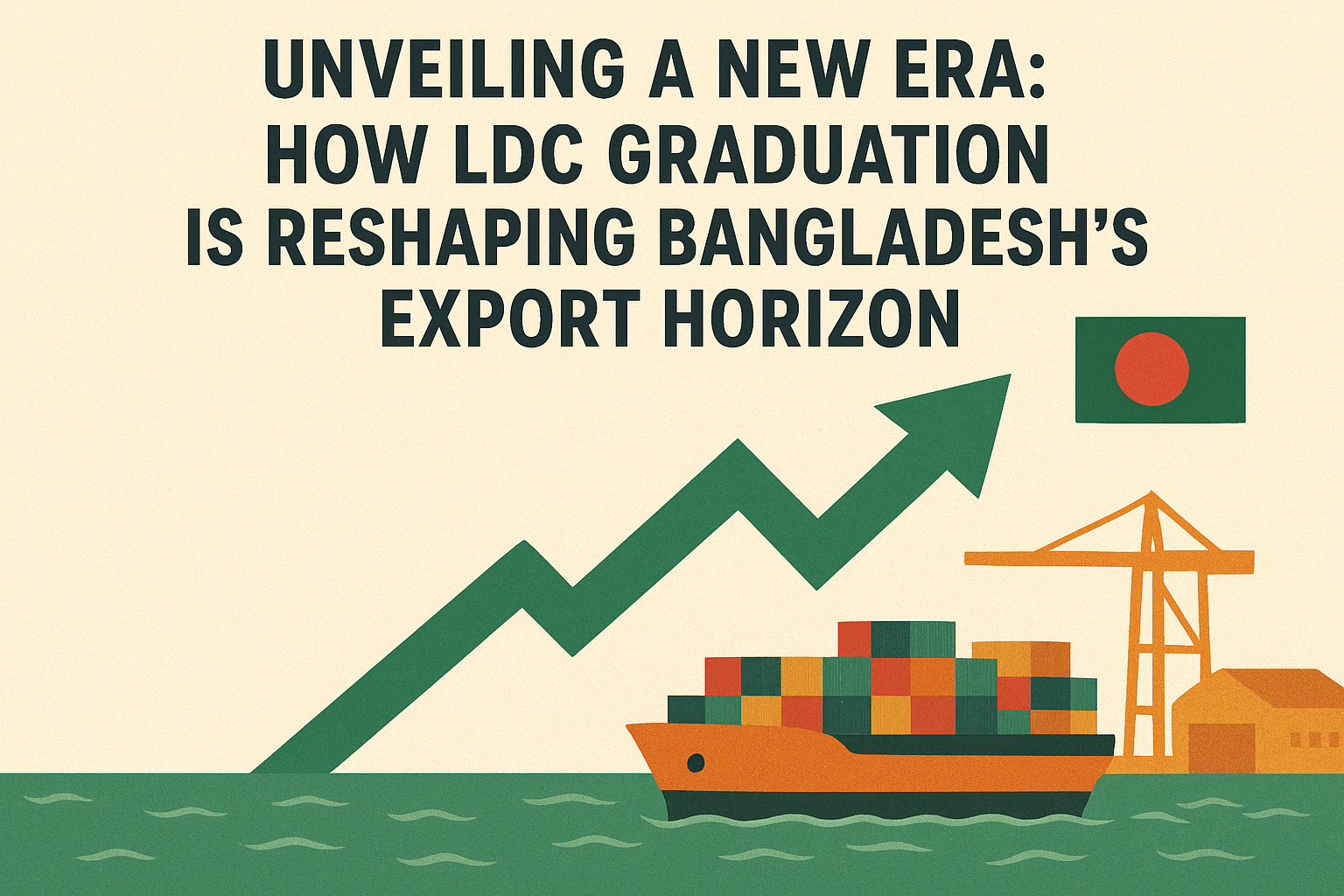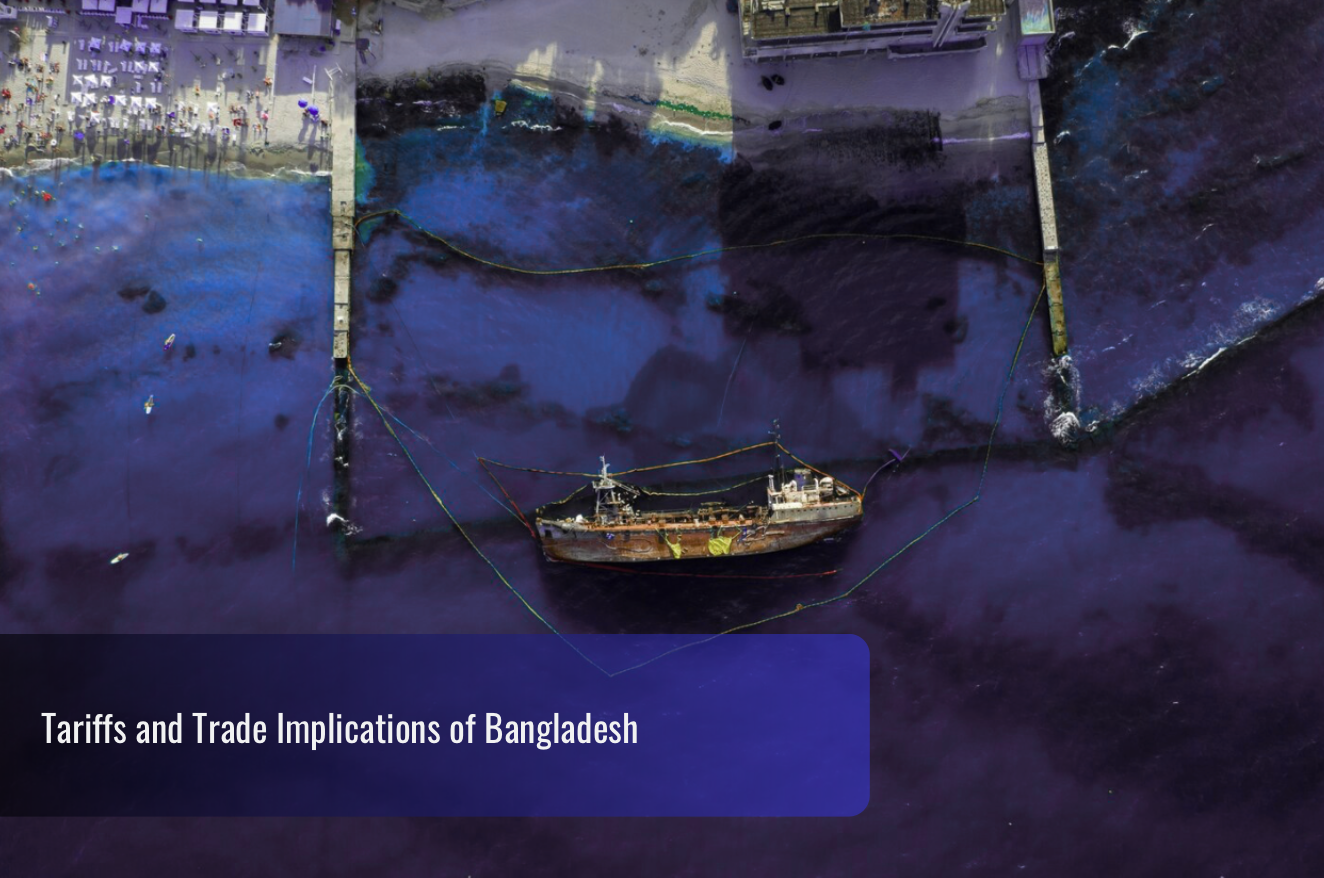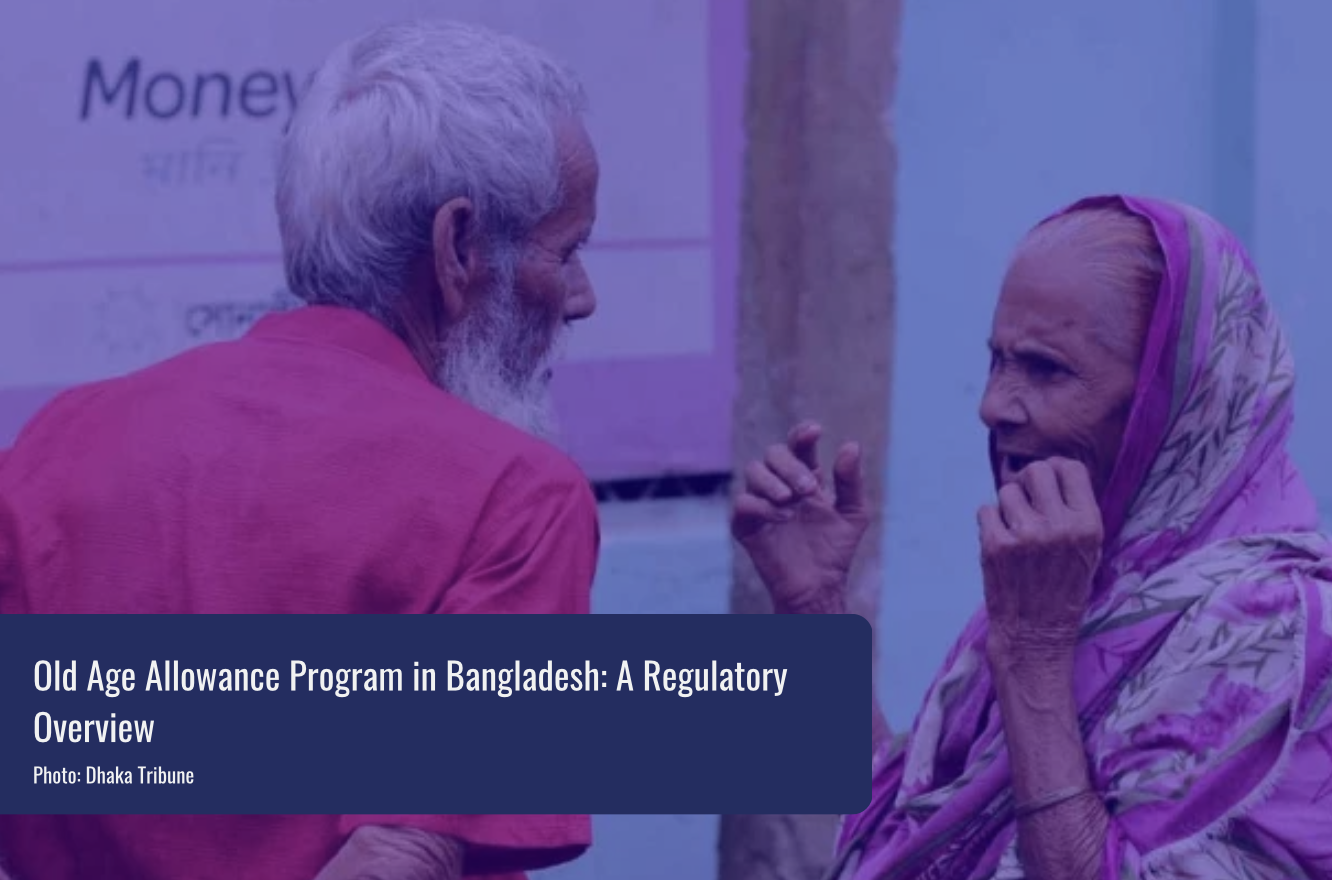The graduation of Bangladesh from the least developed country status is imminent. At present, Bangladesh enjoys the advantage of preferential market access in various nations, but upon gaining graduation status in 2026, its exports will no longer qualify for eligibility. Policymakers are concerned about this development because they believe that Bangladesh’s position as a top exporter may be negatively impacted by the revocation of its title as a least developed country. (Khorana, et al., 2021). Bangladesh’s graduation brings the cessation of LDC-specific market access provisions, LDC-specific special and differential treatment, and flexibilities under WTO regulations and regional agreements. Additionally, it entails the loss of certain training and capacity building mechanisms. With this, Bangladesh will no longer have access to duty-free quota-free (DFQF) arrangements for LDCs and simplified rules of origin exclusively allotted for LDCs. This would have a crucial impact especially on the garment industry (Secretariat of the Committee for Development Policy, 2019). To overcome these challenges, numerous businessmen and experts are recommending the creation of bilateral and regional free trade agreements with various countries, regions, and continents by 2026. This will allow for expansion of the export of goods and services to the global market without relying solely on the GSP or duty-free benefits of certain countries (Haque, 2023). Given the crucial nature of these favorable export market opportunities, the LDC graduation process permits a reasonable amount of time for the anticipated formal graduation in the year 2024. The government of Bangladesh is eager to employ this transitional phase to devise a comprehensive plan for LDC graduation, in order to guarantee that the expenses of graduation, in terms of forfeited benefits, are thoroughly comprehended and adequate strategies and policies are established to facilitate a seamless transition from LDC status (General Economics Division, 2020).
The LDC Graduation: An Achievement Worthy of Commemoration
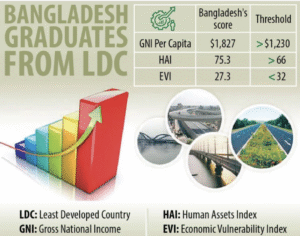
Source: Nafiu (2021).
Figure 1: LDC Graduation of Bangladesh
Bangladesh is poised to transition from its status as a Least Developed Country (LDC) in November 2026. Having been included in this classification for a period of 46 years, the country has satisfied all three criteria which are evaluated triennially by the Committee for Development Policy (CDP) of the United Nations, for the second time in February 2021, and has received the conclusive recommendation to graduate. During its 76th session, the United Nations General Assembly (UNGA) passed the resolution concerning Bangladesh’s graduation from the category of Least Developed Countries (LDCs). In the year 2018, Bangladesh successfully met all three criteria required for graduation, signifying a remarkable achievement. These criteria, including the Gross National Income (GNI), Human Assets Index (HAI), and Economic and Environmental Vulnerability Index (EVI), are crucial indicators of a country’s per capita income levels, human assets, and ability to cope with economic and environmental challenges. By meeting these benchmarks, a country’s capability to continue on the path of progress and its corresponding assistance requirements are evaluated. Bangladesh has exhibited exceptional performance across all three indexes, surpassing expectations as only two are necessary for a recommendation in graduating LDC status (Sarwar, 2021). This accomplishment not only demonstrates the country’s economic strength over a sustained period but also its resilience in times of crisis, such as the COVID-19 pandemic (Wing, 2023).
The Impact on Export Unveiled:
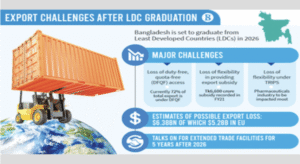
Figure 2: Export Challenges after LDC Graduation
Source: Islam (2023)
The graduation of LDC graduates often leads to economic challenges, particularly in case of Bangladesh, the loss of LDC-specific international support measures like preferential market access. This decline in privileges and preferences, while normal, will have a negative impact on Bangladesh’s exports, particularly its apparel products, to European and North American markets. This loss is estimated to result in a shortfall of 8-10 percent of Bangladesh’s gross export revenue, equivalent to nearly USD 2.5 billion annually. Under GSP, the nation has duty-free access to 38 nations, including the UK and 27 EU nations, where the majority of our garment exports are focused (Wing, 2023). Once it leaves the LDC group, Bangladesh’s duty-free trading facilities under the World Trade Organization’s generalized system of preferences will be reduced. As a result of this graduation, Bangladesh will no longer be eligible for LDC-specific special and differential treatment, which is designed to help LDCs increase their participation in international trade under the WTO agreement (Shazzad, 2021). Furthermore, after the economic transition, Bangladesh shall no longer be eligible for grants and soft loans under official development assistance (ODA) that it has been receiving since the year 1971. The commitment of developed nations to provide 0.15-0.20 percent of their Gross National Income (GNI) in the form of ODA to LDCs cannot be accessed by Bangladesh after attaining the status of a developing country (Shazzad, 2021). This could cause the country’s progress towards development to face temporary obstacles due to the discontinuation of access to LDC-exclusive concessional finances.
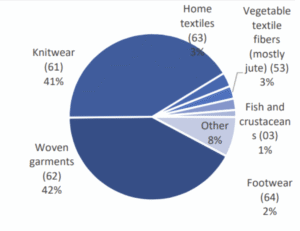
Figure 3: list of exports’ components in Bangladesh, (July 2017-June 2018).
Source: Export Promotion Bureau of Bangladesh, (2017-2018).
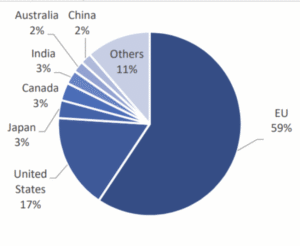
Figure 4: Destination of Bangladesh exports, (July 2017-June 2018).
Source: Export Promotion Bureau report. Region Wise Export (Goods) (2017-2018).
At present, a significant proportion of Bangladesh’s merchandise is exported through preferential market facilities, amounting to a staggering 75 percent. However, following its exit from the list of Least Developed Countries (LDCs), the nation is expected to suffer a colossal loss of export revenue estimated at $7 billion in 2027, which is a daunting prospect (Textile Today, 2023).
Regrettably, it is anticipated that Bangladesh’s export sector, particularly the ready-made garments segment, will bear the brunt of this development. Consequently, the US and European markets may experience a greater impact. As things stand, approximately 83% of Bangladesh’s export revenue is derived from garments, which would be subject to a tariff of 9.6% under the GSP in the EU. In addition, Bangladeshi exporters would also have to meet more rigorous rules of origin to qualify for GSP benefits than they do as a Least Developed Country (LDC) under the Everything But Arms (EBA) initiative.
Strategies to combat the situation:
In this particular scenario, the experts in economics opine that it is imperative to sustain apparel exports to the US market, given the growth potential in this sector. It is crucial to explore avenues such as Free Trade Agreements (FTAs), Preferential Trade Agreements (PTAs), and Economic Partnerships that can be leveraged to attract foreign investments and enhance the quality of the products (Textile Today, 2023).
The Ministry of Commerce has already taken steps to initiate preferential market facilities. There are ongoing negotiations in various forums, such as the World Trade Organization (WTO), to ensure the continuation of market privileges with other countries, including the European Union (EU).
Furthermore, the Ministry of Commerce has created a comprehensive list of ten countries with whom they plan to establish a Free Trade Area (FTA). The countries included in this list are Singapore, Indonesia, India, Nepal, Sri Lanka, Japan, USA, Canada, China, and Malaysia.
To address the difficulties of LDC graduation, a national committee has been established under the direction of the Principal Secretary to the Prime Minister. In addition to this, research projects have been launched after identifying seven sectors. The Economic Relations Department (ERD) of the Ministry of Finance is in charge of organizing this program. ‘Support to Sustainable Graduation Project’ has been chosen as the project for this (Textile Today, 2023).
Author: Khairun Ferdous
Reference:
General Economics Division, (2020). Impact Assessment and Coping up Strategies of Graduation from LDC Status for Bangladesh. Bangladesh Planning Commission.
Haque, M (2023, August 26). Kotota Prostut Bangladesh: LDC theke Uttoroner Challenge Mokabela, The daily Shomokal.
Islam, N.M. (2023, June 12). Free Trade and LDC Graduation of Bangladesh, Daily Sun. https://www.daily-sun.com/printversion/details/694400/Free-Trade-and-LDC-Graduation-of-Bangladesh
Khorana, S., Caram, S., & Biagetti, M. (2021). Developmental relevance of Everything but Arms: Implications for Bangladesh after LDC graduation.
Nafiu, R. F. (2021, February 27). LDC graduation: New opportunities, new challenges. Dhaka Tribune. https://www.dhakatribune.com/bangladesh/development/239719/ldc-graduation-new-opportunities-new-challenges
Secretariat of the Committee for Development Policy, (2019). United Nations Department for Economic and Social Affairs.
Sarwar. (2021). Making Bangladesh’s LDC graduation smooth and sustainable – Fahmida Khatun. Centre for Policy Dialogue (CPD). https://cpd.org.bd/making-bangladeshs-ldc-graduation-smooth-and-sustainable/
Shazzad, H. (2021, December 15). Managing Bangladesh’s LDC graduation: daunting or doable? The Daily Star. https://www.thedailystar.net/views/opinion/news/managing-bangladeshs-ldc-graduation-daunting-or-doable-2917816
Textile Today, (2023). LDC graduation may result in an export loss of $7 billion. Textile News, Apparel News, RMG News, Fashion Trends. https://www.textiletoday.com.bd/ldc-graduation-may-result-in-an-export-loss-of-7-billion
Wing, L. A. (2023). Graduating LDC status: braving challenges and the way forward for Bangladesh. LightCastle Partners. https://www.lightcastlebd.com/insights/2022/10/graduating-ldc-status-braving-challenges-and-the-way-forward-for-bangladesh/

